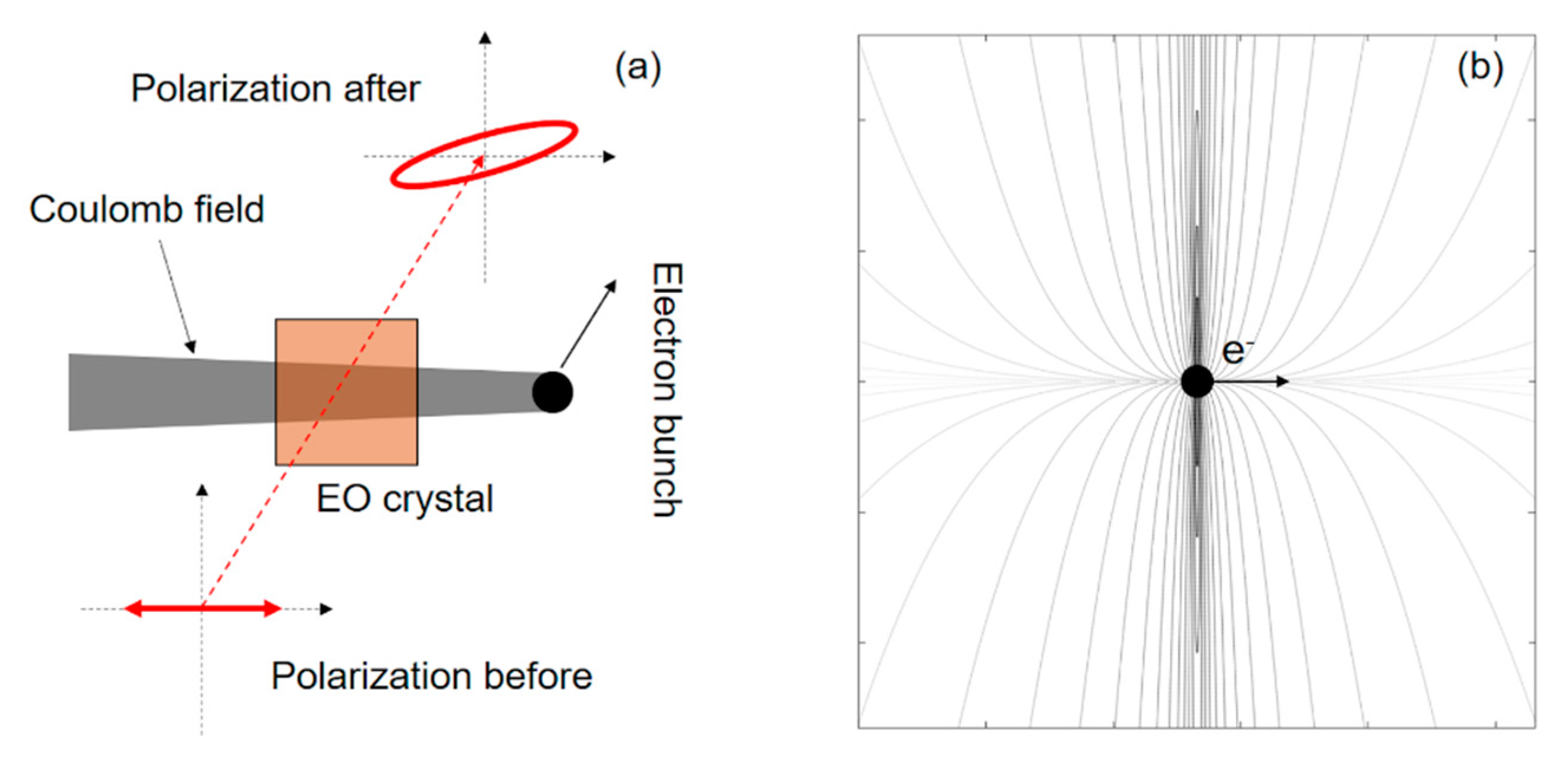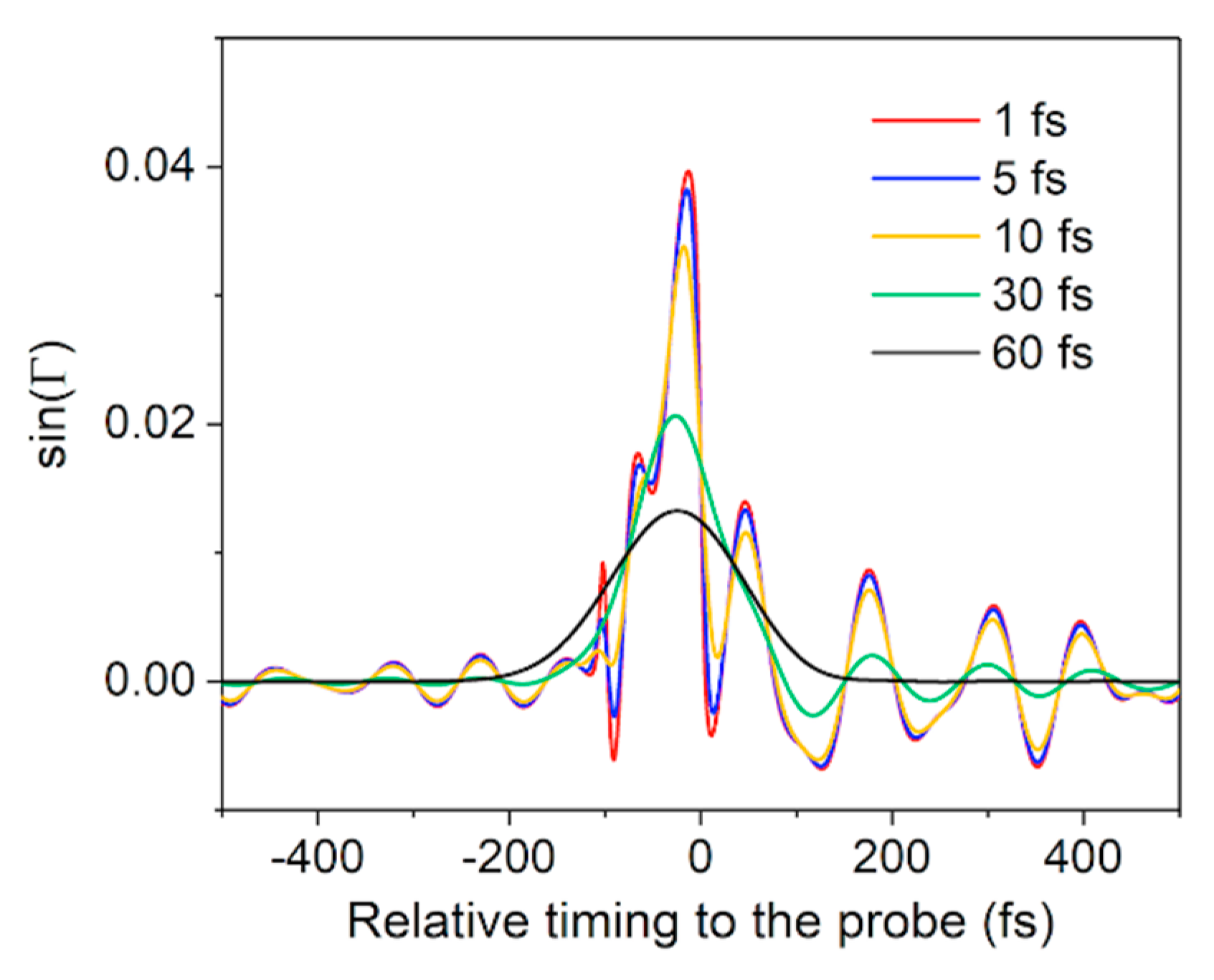Single-Shot Electro-Optic Sampling on the Temporal Structure of Laser Wakefield Accelerated Electrons
Abstract
:1. Introduction
2. Materials and Methods
3. Results
3.1. EO Spatial Decoding Scheme in LWFA
3.2. Multibunch Observation via the EO Spatial Decoding
3.3. Timing Resolution of an EO Sampling
3.3.1. EO Signal Distortion after Propagation through the EO Crystal
3.3.2. Factors Determining the Timing Resolution in a Cross-Polarizer Set-Up in LWFA
3.3.3. Effect of Electron Divergence and Elongation on the Observed Signal Intensity
4. Concluding Remarks and Future Prospects
Author Contributions
Funding
Acknowledgments
Conflicts of Interest
References
- Strickland, D.; Mourou, G. Compression of amplified chirped optical pulses. Opt. Commun. 1985, 56, 219–221. [Google Scholar] [CrossRef]
- Danson, C.; Hillier, D.; Hopps, N.; Neely, D. Petawatt class lasers worldwide. High Power Laser Sci. Eng. 2015, 3. [Google Scholar] [CrossRef]
- Pirozhkov, A.S.; Fukuda, Y.; Nishiuchi, M.; Kiriyama, H.; Sagisaka, A.; Ogura, K.; Mori, M.; Kishimoto, M.; Sakaki, H.; Nicholas, P.D.; et al. Approaching the diffraction-limited, bandwidth-limited Petawatt. Opt. Express 2017, 25, 20486–20501. [Google Scholar] [CrossRef] [PubMed]
- Kiriyama, H.; Alexander, S.P.; Nishiuchi, M.; Fukuda, Y.; Ogura, K.; Sagisaka, A.; Miyasaka, Y.; Sakaki, H.; Nicholas, P.D.; Kondo, K.; et al. Status and progress of the J-KAREN-P high intensity laser system at QST. High Energy Density Phys. 2020. [Google Scholar] [CrossRef]
- Dover, N.P.; Nishiuchi, M.; Sakaki, H.; Kondo, K.; Alkhimova, M.A.; Faenov, A.Y.; Hata, M.; Iwata, N.; Kiriyama, H.; Koga, J.K.; et al. Effect of Small Focus on Electron Heating and Proton Acceleration in Ultrarelativistic Laser-Solid Interactions. Phys. Rev. Lett. 2020, 124. [Google Scholar] [CrossRef] [PubMed] [Green Version]
- Pirozhkov, A.S.; Esirkepov, T.Z.; Pikuz, T.A.; Faenov, A.Y.; Ogura, K.; Hayashi, Y.; Kotaki, H.; Ragozin, E.N.; Neely, D.; Kiriyama, H.; et al. Burst intensification by singularity emitting radiation in multi-stream flows. Sci. Rep. 2017, 7, 1–10. [Google Scholar] [CrossRef]
- Tajima, T.; Dawson, J.M. Laser electron accelerator. Phys. Rev. Lett. 1979, 43, 267–271. [Google Scholar] [CrossRef] [Green Version]
- Gonsalves, A.J.; Nakamura, K.; Daniels, J.; Benedetti, C.; Pieronek, C.; Raadt, T.C.H.; Steinke, S.; Bin, J.H.; Bulanov, S.S.; Tilborg, J.V.; et al. Petawatt laser guiding and electron beam acceleration to 8 GeV in a laser-heated capillary discharge waveguide. Phys. Rev. Lett. 2019, 122. [Google Scholar] [CrossRef] [Green Version]
- Wang, W.T.; Li, W.T.; Liu, J.S.; Zhang, Z.J.; Qi, R.; Yu, C.H.; Liu, J.Q.; Fang, M.; Qin, Z.Y.; Wang, C.; et al. High-brightness high-energy electron beams from a laser wakefield accelerator via energy chirp control. Phys. Rev. Lett. 2016, 117. [Google Scholar] [CrossRef]
- Lundh, O.; Lim, J.; Rechatin, C.; Ammoura, L.; Ben-Ismaïl, A.; Davoine, X.; Gallot, G.; Goddet, J.-P.; Lefebvre, E.; Malka, V.; et al. Few femtosecond, few kiloampere electron bunch produced by a laser-plasma accelerator. Nat. Phys. 2011, 7, 219–222. [Google Scholar] [CrossRef] [Green Version]
- Couperus, J.P.; Pausch, R.; Köhler, A.; Zarini, O.; Krämer, J.M.; Garten, M.; Huebl, A.; Gebhardt, R.; Helbig, U.; Bock, S.; et al. Demonstration of a beam loaded nanocoulomb-class laser wakefield accelerator. Nat. Commun. 2017, 8, 1–7. [Google Scholar] [CrossRef] [PubMed] [Green Version]
- Leemans, W.; Esarey, E. Laser-driven plasma-wave electron accelerators. Phys. Today 2009, 62, 44–49. [Google Scholar] [CrossRef] [Green Version]
- Nakajima, K. Compact X-ray sources: Towards a table-top free-electron laser. Nat. Phys. 2008, 4, 92–93. [Google Scholar] [CrossRef]
- Van Tilborg, J.; Schroeder, C.B.; Filip, C.V.; Tóth, C.; Geddes, C.G.R.; Fubiani, G.; Huber, R.; Kaindl, R.A.; Esarey, E.; Leemans, W.P. Temporal characterization of femtosecond laser-plasma-accelerated electron bunches using terahertz radiation. Phys. Rev. Lett. 2006, 96. [Google Scholar] [CrossRef] [PubMed]
- Debus, A.D.; Bussmann, M.; Schramm, U.; Sauerbrey, R.; Murphy, C.D.; Major, Z.; Rlein, R.H.; Veisz, L.; Schmid, K.; Schreiber, J. Electron bunch length measurements from laser-accelerated electrons using single-shot THz time-domain interferometry. Phys. Rev. Lett. 2010, 104. [Google Scholar] [CrossRef] [PubMed] [Green Version]
- Shan, J.; Weling, A.S.; Knoesel, E.; Bartels, L.; Bonn, M.; Nahata, A.; Reider, G.A.; Heinz, T.F. Single-shot measurement of terahertz electromagnetic pulses by use of electro-optic sampling. Opt. Lett. 2000, 25, 426–428. [Google Scholar] [CrossRef]
- Yan, X.; MacLeod, A.M.; Gillespie, W.A.; Knippels, G.M.H.; Oepts, D.; Meer, A.F.G.; Seidel, W. Subpicosecond electro-optic measurement of relativistic electron pulses. Phys. Rev. Lett. 2000, 85, 3404–3406. [Google Scholar] [CrossRef]
- Wilke, I.; MacLeod, A.M.; Gillespie, W.A.; Berden, G.; Knippels, G.M.H.; Meer, A.F.G. Single-shot electron-beam bunch length measurements. Phys. Rev. Lett. 2002, 88. [Google Scholar] [CrossRef] [Green Version]
- Berden, G.; Jamison, S.P.; MacLeod, A.M.; Gillespie, W.A.; Redlich, B.; Meer, A.F.G. Electro-optic technique with improved time resolution for real-time, nondestructive, single-shot measurements of femtosecond electron bunch profiles. Phys. Rev. Lett. 2004, 93, 114802. [Google Scholar] [CrossRef] [Green Version]
- Steffen, B.; Arsov, V.; Berden, G.; Gillespie, W.A.; Jamison, S.P.; MacLeod, A.M.; Meer, A.F.G.; Phillips, P.J.; Schlarb, H.; Schmidt, B.; et al. Electro-optic time profile monitors for femtosecond electron bunches at the soft X-ray free-electron laser FLASH. Phys. Rev. ST Accel. Beams 2009, 12. [Google Scholar] [CrossRef] [Green Version]
- Steffen, B.R. Electro-Optic Methods for Longitudinal Bunch Diagnostics at FLASH (No. DESY-THESIS-2007-020). Available online: https://bib-pubdb1.desy.de/record/84041/files/desy-thesis-07-020.pdf (accessed on 6 July 2020).
- Wang, W.; Du, Y.C.; Yan, L.X.; Chi, Z.J.; Zhang, Z.; Hua, J.F.; Huang, W.H.; Tang, C.X.; Li, M. Temporal profle monitor based on electro-optic spatial decoding for low-energy bunches. Phys. Rev. Accel. Beams 2017, 20. [Google Scholar] [CrossRef] [Green Version]
- Huang, K.; Esirkepov, T.; Koga, J.K.; Kotaki, H.; Mori, M.; Hayashi, Y.; Nakanii, N.; Bulanov, S.V.; Kando, M. Electro-optic spatial decoding on the spherical-wavefront Coulomb fields of plasma electron sources. Sci. Rep. 2018, 8, 1–10. [Google Scholar] [CrossRef] [PubMed] [Green Version]
- Esarey, E.; Schroeder, C.B.; Leemans, W.P. Physics of laser-driven plasma-based electron accelerators. Rev. Mod. Phys. 2009, 81. [Google Scholar] [CrossRef]
- Chen, M.; Schroeder, C.B.; Geddes, C.G.R.; Leemans, W.P. Theory of ionization-induced trapping in laser-plasma accelerators. Phys. Plasmas 2012, 19. [Google Scholar] [CrossRef]
- Huang, K.; Kotaki, H.; Mori, M.; Esirkepov, T.; Koga, J.K.; Hayashi, Y.; Nakanii, N.; Bulanov, S.V.; Kando, M. Variation in electron emission time in weakly nonlinear laser wakefield acceleration. Phys. Rev. Accel. Beams 2019, 22. [Google Scholar] [CrossRef] [Green Version]
- Wang, X.K.; Cui, Y.; Sun, W.F.; Ye, J.S.; Zhang, Y. Terahertz real-time imaging with balanced electro-optic detection. Opt. Commun. 2010, 283, 4626–4632. [Google Scholar] [CrossRef]
- Bulanov, S.; Naumova, N.; Pegoraro, F.; Sakai, J. Particle injection into the wave acceleration phase due to nonlinear wake wave breaking. Phys. Rev. E 1998, 58. [Google Scholar] [CrossRef] [Green Version]






© 2020 by the authors. Licensee MDPI, Basel, Switzerland. This article is an open access article distributed under the terms and conditions of the Creative Commons Attribution (CC BY) license (http://creativecommons.org/licenses/by/4.0/).
Share and Cite
Huang, K.; Kotaki, H.; Mori, M.; Hayashi, Y.; Nakanii, N.; Kando, M. Single-Shot Electro-Optic Sampling on the Temporal Structure of Laser Wakefield Accelerated Electrons. Crystals 2020, 10, 640. https://doi.org/10.3390/cryst10080640
Huang K, Kotaki H, Mori M, Hayashi Y, Nakanii N, Kando M. Single-Shot Electro-Optic Sampling on the Temporal Structure of Laser Wakefield Accelerated Electrons. Crystals. 2020; 10(8):640. https://doi.org/10.3390/cryst10080640
Chicago/Turabian StyleHuang, Kai, Hideyuki Kotaki, Michiaki Mori, Yukio Hayashi, Nobuhiko Nakanii, and Masaki Kando. 2020. "Single-Shot Electro-Optic Sampling on the Temporal Structure of Laser Wakefield Accelerated Electrons" Crystals 10, no. 8: 640. https://doi.org/10.3390/cryst10080640




